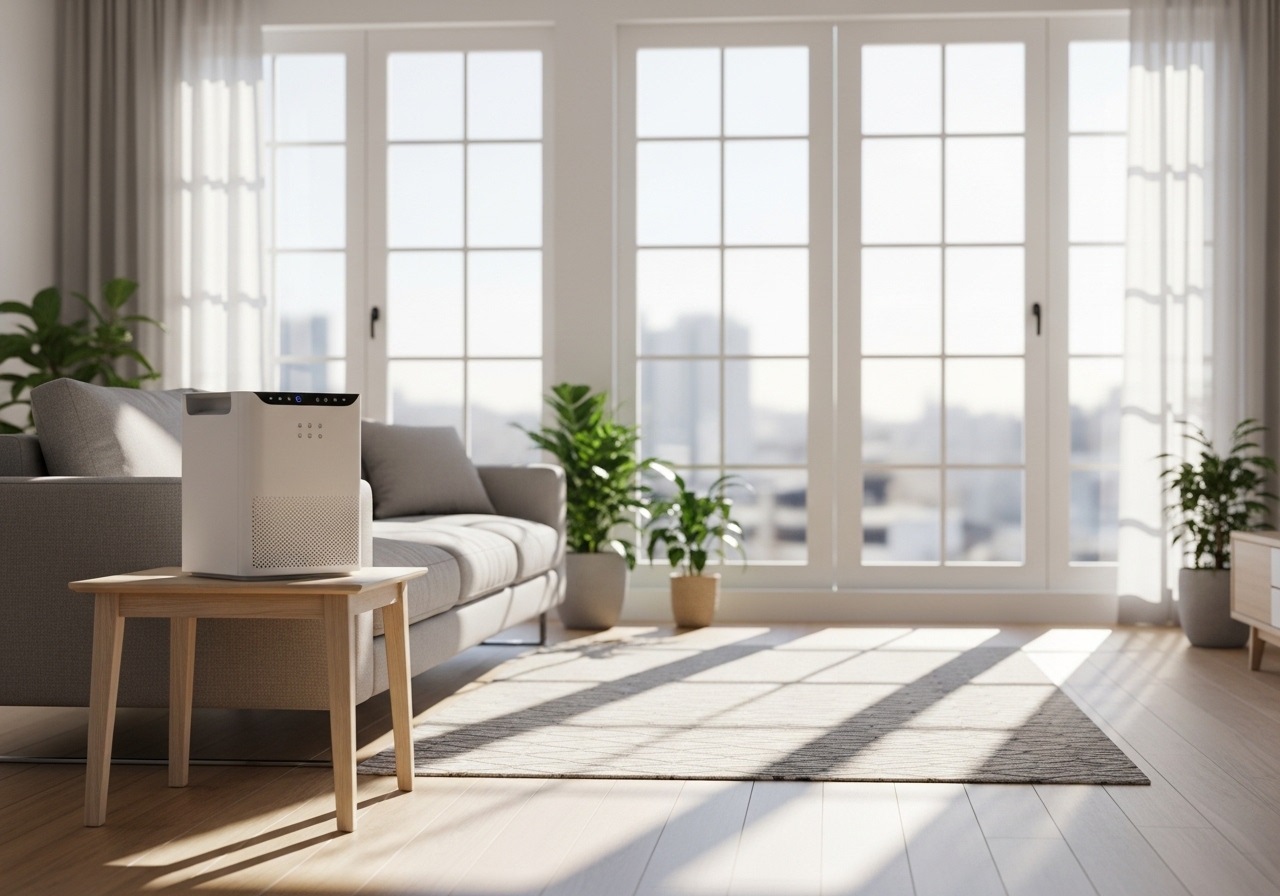The air inside our homes plays a crucial role in our health and well-being, yet it often goes overlooked. According to the Environmental Protection Agency, indoor air can actually be two to five times more polluted than outdoor air. From the subtle emissions of building materials to the more obvious sources like cooking fumes, pet dander, and cleaning products, our living spaces harbor numerous pollutants that silently affect our health daily.
Understanding Indoor Air Quality
Indoor air quality encompasses the condition of air within enclosed spaces and directly impacts the health and comfort of everyone in your home. Poor air quality isn’t just about immediate discomfort; it connects to both short-term problems like headaches and fatigue and long-term health concerns including worsened asthma, persistent allergies, and even cardiovascular issues.
The culprits behind poor indoor air are diverse: microscopic dust particles, pet dander, invisible mold spores, volatile organic compounds (VOCs) released from everyday products, and particulate matter generated during cooking and combustion. Ironically, our push for energy efficiency has led to tighter home construction that, while saving energy, can trap these pollutants inside making deliberate air quality management not just beneficial but necessary.

Key Factors Affecting Indoor Air Quality
Ventilation functions as your home’s respiratory system, cycling fresh air in while pushing stale, contaminated air out. When this airflow becomes inadequate, pollutants linger and accumulate, creating an environment where allergens and irritants can reach problematic levels.
Humidity Levels strike a delicate balance in your home’s atmosphere. Excessive moisture creates the perfect breeding ground for mold and dust mites, while air that’s too dry can irritate sensitive respiratory tissues and leave you more vulnerable to colds and infections.
Household Products from everyday cleaners to scented candles and personal care items often release chemicals that compromise air quality. Even products marketed as “fresh-scented” can introduce potentially harmful compounds into your breathing space.
Building Materials such as certain types of flooring, composite wood furniture, and various insulation materials can silently emit VOCs for years after installation, creating an ongoing source of indoor pollution that’s easy to miss.
Practical Strategies to Improve Indoor Air Quality
Regular Cleaning and Maintenance
Consistent cleaning routines dramatically reduce airborne particles in your living space. For best results, invest in a vacuum equipped with a HEPA filter that captures even the tiniest particles rather than redistributing them into the air. When dusting, choose microfiber cloths that trap dust particles instead of cotton materials that often just redistribute them. Consider switching to simpler, non-toxic cleaning alternatives like vinegar, baking soda, and plant-derived products that get the job done without introducing harsh chemicals.
Managing Humidity and Moisture
Keeping humidity levels within the sweet spot of 30% to 50% creates conditions that discourage both mold growth and dust mite proliferation. Winter heating typically strips moisture from indoor air, while summer humidity often brings unwanted dampness. Strategic use of dehumidifiers and humidifiers can help maintain this balance, making your home both healthier and more comfortable. Don’t overlook the importance of addressing water leaks immediately and ensuring proper ventilation in naturally damp areas like bathrooms, laundry rooms, and kitchens.

Enhancing Ventilation
Boost your home’s air circulation by opening windows when weather conditions allow, using exhaust fans during cooking and showering, and scheduling regular HVAC maintenance to ensure systems work efficiently. In homes where outdoor pollution is a concern or for those with allergies, quality air purifiers with true HEPA filtration can remove an impressive 99.97% of airborne particles as small as 0.3 microns particles far too small for the naked eye to see.
Reducing Chemical Pollutants
Minimize your exposure to harmful chemicals by choosing low-VOC or fragrance-free products for everything from cleaning supplies to personal care items. When possible, store chemicals like paints, solvents, and pesticides in garages or sheds rather than inside your living spaces. Always ventilate thoroughly during and after using these products. Many homeowners find that incorporating certain houseplants like spider plants, peace lilies, and snake plants adds both aesthetic appeal and natural air-filtering properties, as these plants can help absorb certain airborne chemicals.
Special Considerations for Sensitive Groups
Children, elderly individuals, and those with respiratory conditions require extra attention to air quality. These vulnerable groups often benefit from creating dedicated “clean air zones” in bedrooms spaces with minimal furnishings, easily washable bedding, and dedicated air purifiers. A simple habit like removing shoes at the door prevents tracking in outdoor pollutants, including lead dust and pesticides. When possible, schedule deep cleaning activities when sensitive individuals can be away from home for a few hours.
Real-World Scenarios and Practical Tips
One family struggling with year-round allergy symptoms made a remarkable discovery when they simply upgraded their HVAC filters and committed to vacuuming twice weekly their medication use dropped by nearly half within a month. In another household, persistent unexplained headaches disappeared after identifying and removing a recently purchased particle board bookcase that was emitting high levels of formaldehyde.

Key Takeaway Box:
- Open windows for 5-10 minutes daily, even in extreme weather
- Keep humidity consistently between 30-50%
- Use HEPA filtration for both vacuuming and air purification
- Select low-VOC products for all household needs
- Treat water issues immediately to prevent mold establishment
Conclusion
Taking control of your indoor air quality represents one of the most impactful yet frequently overlooked aspects of creating a truly healthy home. Start by becoming more aware of your current situation pay attention to lingering odors, dust accumulation patterns, and any symptoms that seem to improve when you’re away from home.
Begin implementing the strategies discussed, prioritizing those that address your most immediate concerns. For persistent issues, particularly those affecting health, consider reaching out to indoor air quality specialists who can provide professional testing and customized recommendations for your specific living environment.
Remember that improving your home’s air isn’t a one-time project but rather an ongoing commitment to creating a healthier living environment one that will benefit everyone who walks through your door.






























